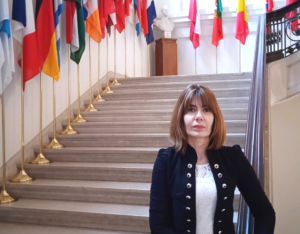Seminar: Adsorption / Chemistry | April 21 | 4 p.m.-5 p.m. | Auditorium FCiências.ID (FCUL C1)
Leticia Fernández Velasco, Department of Chemistry, Royal Military Academy, Brussels, Belgium

How water vapor sorption can contribute to a greener future?
Host: Ana S. Mestre
With the financial support of:

European Union’s Horizon Europe HORIZON-EIC under Grant Agreement No. 101046307.

Belgian Defence
Water is ubiquitous in the atmosphere and has unique properties, making it one of the most fascinating molecules to be investigated. Specifically, the behavior of water sorbed in nanoconfined spaces is attracting a lot of attention in the last years.
On the one hand, water vapour sorption has revealed as an advantageous characterization technique of different porous materials, ranging from nanocarbons to metal organic frameworks. This is due to the fact that, differently from other adsorbates, it can provide information about both their textural properties and their surface chemistry [1,2].
Furthermore, water adsorption can be also useful in applied sciences, especially in the environmental and energetic fields. Water is present everywhere and at any time, so its influence needs to be always considered when evaluating the performance of the materials in different applications [3,4]. At the same time, it can offer a new source of renewable energy.
In this seminar, I will give an overview of these three aspects and show how water adsorption can contribute to a greener future by means of i) the advanced characterization of sustainable materials, ii) the assessment of their stability and efficiency during physical and reactive adsorption for air decontamination, and iii) the conversion of ambient humidity to electricity, which we are currently studying in the frame of the CATCHER project, funded by the European Union.
[1] Velasco LF, Guillet-Nicolas R, Dobos G, Thommes M, Lodewyckx P, Carbon 96 (2016), 753–758.
[2] Velasco LF, Snoeck D, Mignon A, Misseeuw L, Ania CO, Van Vlierberghe S, Dubruel P, de Belie N, Lodewyckx P, Carbon 106 (2016), 284–288.
[3] Lodewyckx P, Velasco LF, Boutillara Y, Eurasian Chemico-Technological Journal 21(3) (2019).
[4] Velasco LF, Kim KH, Lee Y-S, Lodewyckx P, Frontiers in Chemistry 8 (2021).